Have you ever wondered why your gas stove flame too high, despite following all the manufacturer’s instructions? This common yet perplexing issue wastes energy and poses significant safety risks. Fortunately, identifying and fixing a high flame on your gas stove is not as daunting as it might seem.

“In the battle of man versus machine, sometimes the smallest adjustments make the biggest difference,” remarked a seasoned appliance repair technician. Reflecting on this insight, it’s clear that a little know-how can go a long way in managing your kitchen’s fire power.
In this post, you’ll learn how to troubleshoot and resolve high flame issues, ensuring your stove operates safely and efficiently. We’ll cover everything from simple adjustments to more in-depth fixes, such as how to adjust gas stove flame height and what to do if your gas stove burner is stuck on high flame. Whether you’re facing erratic flames or a burner that won’t tame, this guide will equip you with the knowledge to handle it confidently and safely.
Is Your Gas Stove Flame Too High
Why does your gas stove burner flame too high even when you’ve barely turned the knob? This frustrating situation can not only lead to burnt meals but also elevate the risk of kitchen accidents. Let’s dig into the reasons behind this fiery problem.
The first thing to consider is gas pressure irregularities. As one expert puts it, “Most often, the flame that dances wildly is not just a stove’s quirk but a whisper of underlying issues.” This means if your gas stove flame is too high suddenly, there might be an inconsistency in how gas is delivered to your stove.
Another common culprit could be the burner orifice being either clogged or incorrectly fitted. A clogged burner orifice can disrupt the flow of gas, causing an uneven and high flame. Regular cleaning and maintenance are your best defense against such issues.
Lastly, don’t overlook the regulator malfunction. This component controls the gas pressure; if it fails, you’ll notice your gas stove burner stuck on high flame more frequently. Checking and replacing the regulator could be the key to solving this high-flame drama.
Preliminary Checks Before Gas Stove Flame Adjustment
Before you go for gas stove flame adjustment, it’s crucial to conduct a few preliminary checks to ensure safety and identify the root cause of the problem. Let’s walk through these essential steps.
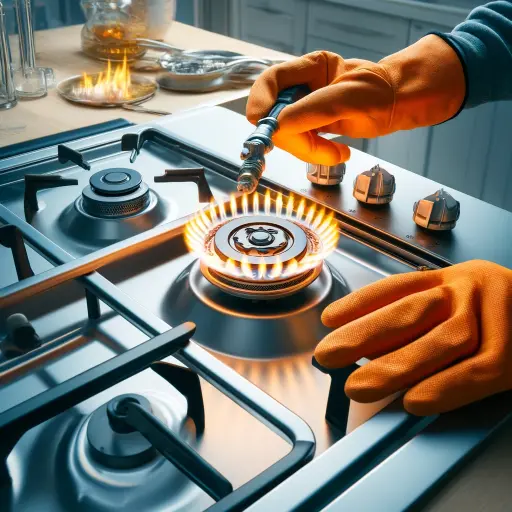
First, make sure your stove is completely turned off and cool to the touch. This might seem obvious, but safety should always be your top priority. As the saying goes, “An ounce of prevention is worth a pound of cure.”
Second, inspect the gas supply line for any visible signs of wear or damage. A compromised gas line can be a serious hazard and might contribute to the gas stove burner flame being too high.
Third, take a close look at the burner itself. Debris and food residues can accumulate around the burner, leading to blockages that cause a high flame. Cleaning the burner thoroughly can often resolve this issue without further adjustments.
Lastly, check the regulator to ensure it’s functioning correctly. A faulty regulator is a common reason for sudden high flames and should be addressed by a professional if found defective.
By conducting these checks, you’re not only preparing to safely adjust your stove but also pinpointing potential problems that could save you from unnecessary adjustments or repairs.
Adjust Gas Stove Flame: Step-by-Step Guide
When dealing with a gas stove burner flame too high, proper adjustment and maintenance can often resolve the issue effectively. This section will guide you through detailed steps to adjust your stove’s flame, ensuring it is safe and optimal for everyday cooking.
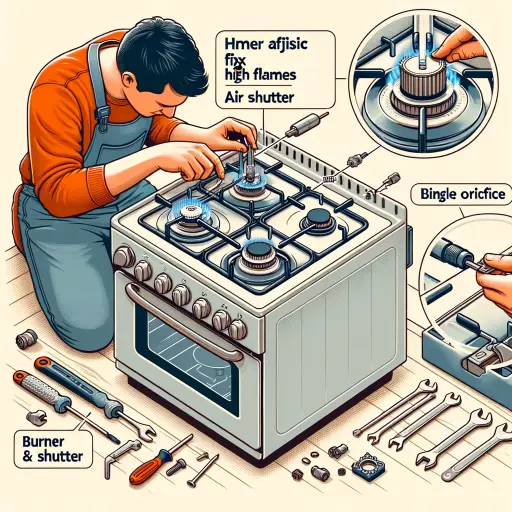
Gather Necessary Tools
Before you begin any maintenance or adjustment on your gas stove, it’s crucial to have the right tools at hand. This ensures that you can proceed without interruption and handle the task safely and efficiently. Here’s what you’ll typically need:
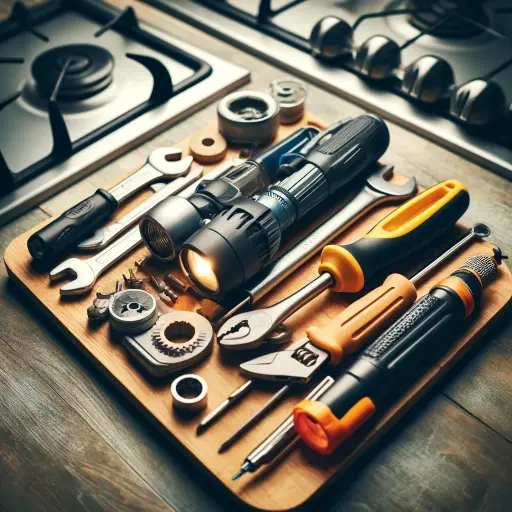
- Screwdriver: For adjusting components like the burner air shutter and accessing parts that may be screwed in place.
- Needle or Small Wire: This is essential for cleaning out the burner orifices. A blocked orifice can cause an irregular flame, and clearing any blockages can often rectify a high flame issue.
- Wrench: Useful for making adjustments to the gas supply line or the regulator if necessary. Ensure you have the right size to fit the nuts and bolts on your stove.
Ensure Safety First
Safety is paramount when dealing with any gas appliance. Follow these safety precautions to prevent accidents:
- Turn Off the Gas Supply: Make sure the gas supply is completely shut off to your stove to eliminate the risk of gas leakage or accidental ignition during maintenance.
- Ensure Good Ventilation: Open windows or use an exhaust fan to keep the area well-ventilated, reducing the risk of gas buildup.
- Check for Open Flames or Sparks: Ensure there are no open flames, lit cigarettes, or operating electrical tools that could ignite gas in the air.
Clean the Burner Orifices
Clogged burner orifices are a common cause of high flame issues as they restrict the normal flow of gas, causing it to exit under higher pressure. To clean the orifices:
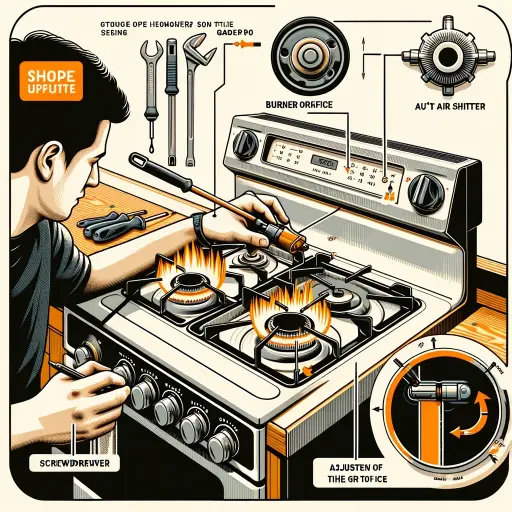
- Locate the Orifices: These are typically found at the base of the burner where the gas exits to fuel the flame.
- Use a Needle or Small Wire: Gently insert the needle or wire into the orifice to remove debris, such as food particles or built-up grime.
- Be Gentle: It’s important to be gentle to avoid damaging the orifices. Harsh poking could misshape the orifice and worsen the flame issue.
Adjust the Burner Air Shutter
The air shutter controls the mix of air and gas, which determines the flame quality. An improper mix can cause a high, weak, or yellow flame.
- Locate the Air Shutter: This is usually positioned at the base of the burner, near where the gas line connects to the burner.
- Adjusting the Shutter: Loosen the screw on the air shutter slightly. Slide the shutter incrementally to increase or decrease the air flow. More air typically reduces the flame size, while less air makes it larger.
- Test and Retighten: After adjusting, tighten the screw to lock the shutter in place. Test the flame and readjust if necessary to achieve a perfect blue flame with minimal yellow tipping.
Check and Adjust the Gas Pressure Regulator
The regulator is vital as it controls the pressure of the gas coming from your supply to your stove. An incorrectly adjusted or faulty regulator can result in a consistently high flame.
- Locate the Regulator: This is usually found where the main gas supply connects to the stove.
- Inspect for Visible Damage: Check the regulator for any signs of wear, damage, or leakage.
- Adjusting the Regulator: This task can be complex and requires specific knowledge of your stove’s gas system. If you suspect an issue with the regulator, it might be best to call a professional. Adjusting a regulator without proper knowledge can be dangerous.
Test and Fine-tune Each Burner
Once you have cleaned the orifices and adjusted the air shutter, it’s important to test each burner individually to ensure the adjustments have been effective:
- Turn On the Gas Supply: Carefully turn on the gas supply to the stove.
- Light Each Burner: Use a stove lighter or the automatic ignition feature to light each burner, observing the flame characteristics.
- Observe the Flame: Look for a steady blue flame with minimal yellow tipping. If the flame is still too high or if you see an uneven flame, additional adjustments may be necessary.
- Fine-tune as Needed: Depending on your observations, you may need to revisit the air shutter adjustments or clean the orifices again. This step might require several iterations to perfect the flame.
Regular Maintenance Checks
To prevent future issues with your stove’s flame height and ensure ongoing optimal performance, establish a routine maintenance schedule:
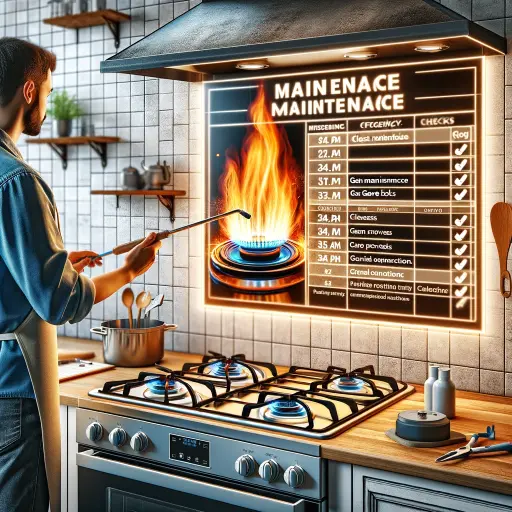
- Schedule Regular Cleaning: Periodic cleaning of the burner orifices and air shutters can prevent build-up that might lead to flame issues.
- Check Gas Connections: Regularly inspect gas lines and connections for leaks or signs of wear. Use soapy water to check for leaks and ensure all fittings are tight.
- Professional Inspections: Consider having your stove checked annually by a professional, especially if you frequently adjust settings or have an older model. They can also verify that the gas pressure and the condition of the regulator are within safe operating parameters.
Seek Professional Help if Needed
While many aspects of gas stove maintenance can be handled DIY, there are situations where professional help is necessary:
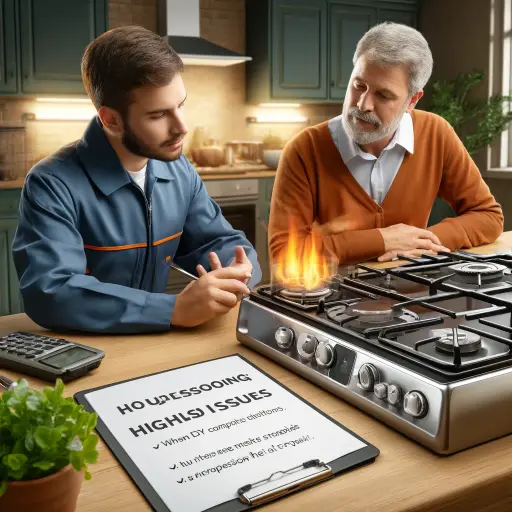
- Complex Adjustments: If adjustments to the gas pressure regulator are needed, or if there are multiple issues affecting stove performance, a certified technician should be involved.
- Persistent Issues: If problems persist after you’ve made all possible adjustments, this might indicate a more complex underlying issue that requires professional diagnosis and repair.
- Safety Concerns: Anytime you’re unsure or uncomfortable with performing maintenance on your gas stove, especially when it involves gas lines or pressure adjustments, it’s prudent to call in a professional.
Document Your Adjustments
Keeping a record of any adjustments or repairs you make can be incredibly helpful, both for ongoing maintenance and for any future troubleshooting:
- Create a Maintenance Log: Note down dates, details of what was cleaned or adjusted, and any parts that were replaced.
- Record Performance Changes: After each adjustment, record how the stove’s performance has improved or if there are still issues. This can help track whether changes are effective or if further adjustments are necessary.
- Share with Professionals: If you end up needing professional help, your maintenance log can provide them with valuable insights into the stove’s history and what has been tried already.
Educate Yourself on Gas Stove Safety
Understanding how to safely operate and maintain your gas stove is crucial for preventing accidents and ensuring efficient operation:
- Learn Safety Protocols: Familiarize yourself with the basic safety measures for using gas stoves, such as what to do in the event of a gas leak.
- Install Safety Devices: Consider installing a carbon monoxide detector in your kitchen if you don’t already have one. Regularly check and maintain it to ensure it’s working properly.
- Stay Informed: Keep up-to-date with any recalls or safety notices related to your model of stove. Manufacturers often provide important updates that can affect safety and performance.
By following these expanded steps, you not only address the immediate issue of a high flame but also contribute to the long-term safety and efficiency of your gas stove.
FAQs and Commonly Unanswered Questions
When it comes to managing gas stove burner flame too high issues, homeowners often have specific questions that might not always be addressed in standard troubleshooting guides. Here, we tackle some of these frequently asked questions and provide clear, practical answers to help you maintain your stove effectively.
Why Is My Gas Stove Flame So High Suddenly?
A sudden increase in flame height can be alarming and is often due to a few specific issues. The most common cause is a malfunction in the gas pressure regulator, which might start allowing too much gas to pass through, resulting in a higher flame. Alternatively, if you have recently cleaned or altered your stove, it’s possible that the burner orifices or air shutters were not properly adjusted afterward. Checking these components and ensuring they are set correctly should resolve the issue.
Gas Stove Flame Too High: Safety Hazard and Solutions
A flame that is too high can pose several safety risks, including the potential for burns or starting a fire. If you notice this problem:
- Immediately Turn Off the Stove: Prevent any accidents by shutting down the stove until the issue can be addressed.
- Check the Installation: Ensure that the stove and gas lines were installed by a professional and meet local safety standards.
- Seek Professional Help: If basic troubleshooting doesn’t fix the high flame, consult a professional technician to avoid risking further damage or safety issues.
Best Way to Adjust Gas Stove Flame Height
Adjusting the flame height on a gas stove typically involves regulating the air shutter and cleaning the burner orifices. Here’s a quick guide:
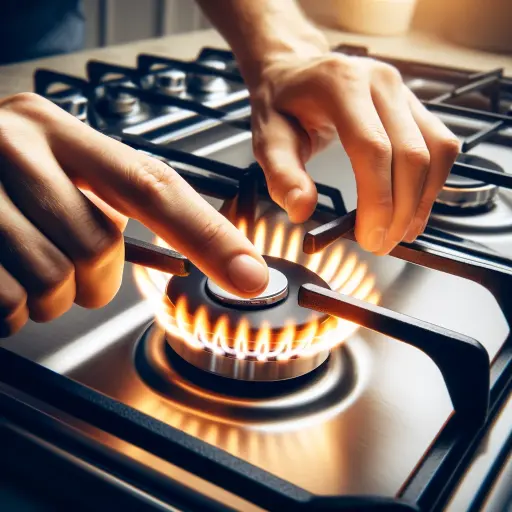
- Adjust the Air Shutter: This control is usually located at the base of the burner. Sliding it slightly can allow more or less air to mix with the gas, helping to control the flame size.
- Clean the Orifices: Use a fine needle to clear any debris from the burner orifices, ensuring that gas can flow smoothly.
- Test and Retune: After making adjustments, light the stove and observe the flame. Continue to make small adjustments until the desired flame height is achieved.
What to Do If Gas Stove Burner Control Knob Is Not Working?
If your stove’s control knob isn’t working, it could be due to a mechanical issue inside the knob mechanism or a disconnection between the knob and the valve. Here’s how to handle it:
- Inspect the Knob: Check for visible damage or misalignment. Sometimes, simply realigning or tightening the knob can restore functionality.
- Check the Connection: Ensure that the knob is correctly connected to the valve stem. If the connection is loose or the stem is damaged, the knob may not function properly.
- Replace if Necessary: If the knob or stem is broken, replacement parts are usually available from the stove’s manufacturer or appliance repair stores.
Conclusion: Fixing the Gas Stove Uneven Flame
In conclusion, addressing a Gas Stove uneven Flame never requires a combination of proactive maintenance, careful adjustments, and adherence to safety protocols. By following the steps outlined in this guide and implementing preventative measures, you can effectively manage high flame issues and ensure the safe and efficient operation of your stove.
Remember, safety should always be your top priority when working with gas appliances. If you encounter any issues that you’re unsure how to handle or if you’re uncomfortable making adjustments yourself, don’t hesitate to seek professional assistance. It’s better to be safe than sorry when it comes to gas-related repairs.
By taking the time to understand your gas stove and implementing proper maintenance practices, you can minimize the risk of high flames and enjoy worry-free cooking in your kitchen. Here’s to many delicious meals cooked safely and efficiently on your gas stove!
